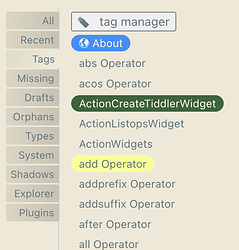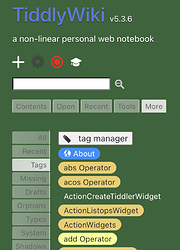This comment pulls in a slightly different direction, but:
Tag COLORS (other than the single default tag-background and tag-foreground) are among the only aspects of TiddlyWiki’s interface that remain especially resistant to palette integration.
I do use different palettes in different wikis (helps me orient to “where I am” given that I may be actively shifting between them in open tabs). AND this means that bringing the tag-pill color along for the ride, when I import a tag’s tiddler, may actually be a small bit of undesired awkwardness to tweak after import.
I use the linkstyle solution in all my wikis, so that some of my tiddler titles and links always display in, say, the current palette’s code-foreground color. I’m also used to tweaking certain interface elements by adding 2 alpha/opacity digits to palette colors in order to get nice effects, etc. Even your filter-pill macro can work with the palette if you set a variable (<$let thisColor={{{ [{$:/palette}getindex[code-foreground]]}}}>…<<filter-pill "[tag[essay]!tag[archive]]" """current essays""" $(thisColor)$ "white">>)
But with tags, it’s either the active palette’s primary default tag color or a hard-selected hex-value as selected for the color field (no alpha, no colour-macro magic). Right?
The result is that a change of palette makes for very different contrast conditions.
I do see why many people prefer explicit fixed colors for certain kinds of tags (hooking into color-associations with green-yellow-red for example… note recent palettes sometimes include such fixed-color options, presumably because of such needs).
Still, sometimes contrast and aesthetic unity is key, and since the palette has a default tag color, it’s quite odd not to be able to work flexibly with other palette-driven ways of working with tags. Generally, I want my wikis (such as my intended biblio community edition) to have tag-contrast AND to be friendly to palette changes.
I suppose I could try to rig something with cascade conditions and the color action plugin… For example, we could make tags respond to their place in a tag-hierarchy with, say, opacity-changes (progressively “diluting” a hex value at the top/parent tag)… or make it so that tags with natural-language strings in their color field (green, red, etc. — which don’t currently work and are hard to edit, given the color-field’s fixation on hex values) would remain rigid…, while other tag-colors would get remapped in harmonious ways (perhaps especially promising on the flexioki-enhanced palette)… Also, we could get a cascade to tweak colored tagpills based on light palette vs dark palette flag… It’s not a high priority for me now though! Just one way in which our support for palettes seems still to be lagging.


